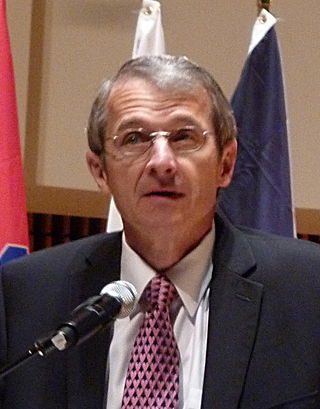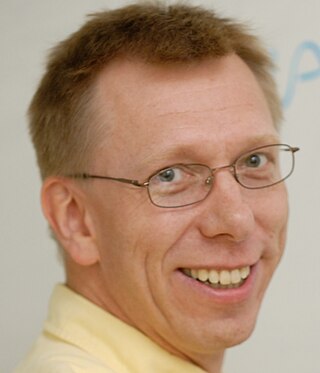Related Research Articles

Arnold Orville Beckman was an American chemist, inventor, investor, and philanthropist. While a professor at California Institute of Technology, he founded Beckman Instruments based on his 1934 invention of the pH meter, a device for measuring acidity, later considered to have "revolutionized the study of chemistry and biology". He also developed the DU spectrophotometer, "probably the most important instrument ever developed towards the advancement of bioscience". Beckman funded the Shockley Semiconductor Laboratory, the first silicon transistor company in California, thus giving rise to Silicon Valley. After retirement, he and his wife Mabel (1900–1989) were numbered among the top philanthropists in the United States.

The Beckman Institute for Advanced Science and Technology is a unit of the University of Illinois Urbana-Champaign dedicated to interdisciplinary research. A gift from scientist, businessman, and philanthropist Arnold O. Beckman (1900–2004) and his wife Mabel (1900–1989) led to the building of the Institute which opened in 1989. It is one of five institutions which receive support from the Arnold and Mabel Beckman Foundation on an ongoing basis. Current research at Beckman involves the areas of molecular engineering, intelligent systems, and imaging science. Researchers in these areas work across traditional academic boundaries in scientific projects that can lead to the development of real-world applications in medicine, industry, electronics, and human health across the lifespan.

Richard Royce Schrock is an American chemist and Nobel laureate recognized for his contributions to the olefin metathesis reaction used in organic chemistry.
Tobin Jay Marks is an inorganic chemistry Professor, the Vladimir N. Ipatieff Professor of Catalytic Chemistry, Professor of Material Science and Engineering, Professor of Chemical and Biological Engineering, and Professor of Applied Physics at Northwestern University in Evanston, Illinois. Among the themes of his research are synthetic organo-f-element and early-transition metal organometallic chemistry, polymer chemistry, materials chemistry, homogeneous and heterogeneous catalysis, molecule-based photonic materials, superconductivity, metal-organic chemical vapor deposition, and biological aspects of transition metal chemistry.
Fred Basolo was an American inorganic chemist. He received his Ph.D. at the University of Illinois at Urbana-Champaign in 1943, under Prof. John C. Bailar, Jr. Basolo spent his professional career at Northwestern University. He was a prolific contributor to the fields of coordination chemistry, organometallic, and bioinorganic chemistry, publishing over 400 papers. He supervised many Ph.D. students. With colleague Ralph Pearson, he co-authored the influential monograph "Mechanisms of Inorganic Reactions", which illuminated the importance of mechanisms involving coordination compounds. This work, which integrated concepts from ligand field theory and physical organic chemistry, signaled a shift from a highly descriptive nature of coordination chemistry to a more quantitative science.
Carl Shipp "Speed" Marvel was an American chemist who specialized in polymer chemistry. He made important contributions to U.S. synthetic rubber program during World War II, and later worked at developing polybenzimidazoles, temperature-resistant polymers that are used in the aerospace industry, in fire-fighting equipment, and as a replacement for asbestos. He has been described as "one of the world's outstanding organic chemists" and received numerous awards, including the 1956 Priestley Medal and the 1986 National Medal of Science, presented by President Ronald Reagan.

Ralph G. Nuzzo is an American chemist and professor. Nuzzo is a researcher in the chemistry of materials, including processes that occur at surfaces and interfaces. His work has led to new techniques for fabricating and manipulating materials at the nano scale level, including functional device structures for microelectronics, optics and chemical sensing.
James P. Collman is an American chemist who is the George A. and Hilda M. Daubert Professor of Chemistry, emeritus at Stanford University. Collman's research focused on organometallic bioinorganic chemistry. Collman is a member of the National Academy of Sciences.
Huimin Zhao is the Steven L. Miller Chair Professor of Chemical and Biomolecular Engineering at the University of Illinois, Urbana-Champaign, as well as the leader of the Biosystems Design research theme in the Carl R. Woese Institute for Genomic Biology. His research focuses on directed evolution, metabolic engineering, bioinformatics and high throughput technologies.

Martin Gruebele is a German-born American physical chemist and biophysicist who is currently James R. Eiszner Professor of Chemistry, Professor of Physics, Professor of Biophysics and Computational Biology at the University of Illinois Urbana-Champaign, where he is the principal investigator of the Gruebele Group.
Jeffrey Scott Moore is the Murchison-Mallory Professor of Chemistry and a Professor of Materials Science & Engineering at the University of Illinois at Urbana–Champaign. He has received awards for both teaching and research, and as of 2014, was named a Howard Hughes Medical Institute Professor. In 2017, he was named director of the Beckman Institute for Advanced Science and Technology at the University of Illinois, after serving as Interim Director for one year.
CatherineJ. Murphy is an American chemist and materials scientist, and is the Larry Faulkner Professor of Chemistry at the University of Illinois at Urbana-Champaign (UIUC). The first woman to serve as the head of the department of chemistry at UIUC, Murphy is known for her work on nanomaterials, specifically the seed-mediated synthesis of gold nanorods of controlled aspect ratio. She is a member of the American Association for the Advancement of Science, National Academy of Sciences, and the American Academy of Arts and Sciences in 2019.
Gregory S. Girolami is the William H. and Janet G. Lycan Professor of Chemistry at the University of Illinois Urbana-Champaign. His research focuses on the synthesis, properties, and reactivity of new inorganic, organometallic, and solid state species. Girolami has been elected a fellow of the American Association for the Advancement of Science, the Royal Society of Chemistry, and the American Chemical Society.
A Beckman Fellow receives funding, usually via an intermediary institution, from the Arnold and Mabel Beckman Foundation, founded by Arnold Orville Beckman and his wife Mabel. The Foundation supports programs at several institutions to encourage research, particularly the work of young researchers who might not be eligible for other sources of funding. People from a variety of different programs at different institutions may therefore be referred to as Beckman Fellows. Though most often designating postdoctoral awards in science, the exact significance of the term will vary depending on the institution involved and the type(s) of Beckman Fellowship awarded at that institution.
Nancy Makri is the Edward William and Jane Marr Gutgsell Endowed Professor of Chemistry and Physics at the University of Illinois Urbana–Champaign, where she is the principal investigator of the Makri Research Group for the theoretical understanding of condensed phase quantum dynamics. She studies theoretical quantum dynamics of polyatomic systems, and has developed methods for long-time numerical path integral simulations of quantum dissipative systems.
Jiri Jonas is a professor emeritus of chemistry in the Center for Advanced Study at the University of Illinois at Urbana-Champaign. Jiri Jonas is considered a pioneer in the use of magnetic resonance imaging at high pressure, developing techniques to study the dynamic structure of liquids and proteins. This approach has been used in the study of the arc repressor, a DNA-binding protein containing 53 amino acid residues.

Erick M. Carreira is a Cuban-born American organic chemist and professor at ETH Zürich. He is known for his research group's work in total synthesis projects, particularly asymmetric synthesis of complex natural products. He became the editor-in-chief of the Journal of the American Chemical Society in 2021.
Jonathan V Sweedler is an American chemist specializing in bioanalytical chemistry, neurochemistry and cell to cell biology and behavior. He is the James R. Eiszner Family Endowed Chair in Chemistry at the University of Illinois at Urbana-Champaign. Additionally, he holds a faculty appointment in the Beckman Institute. He is also an Elected Fellow to the American Chemical Society, for which he is also the society's Editor in Chief for the journal Analytical Chemistry.

Wilfred A. van der Donk is a Dutch–American enzymologist and chemical biologist. He is the Richard E. Heckert Chair in Chemistry at the University of Illinois Urbana-Champaign.
Liviu M. Mirica is the Janet and William H. Lycan Professor of Chemistry at the University of Illinois at Urbana-Champaign, known for his work in organometallic chemistry and nickel-based catalysis. He was elected in 2018 as a Fellow of the Royal Society of Chemistry, and in 2022 as a Fellow of the American Association for the Advancement of Science. His research interests include using synthetic, inorganic and organometallic chemistry to study novel transition metal complexes with applications for sustainable catalysis. He has also worked on developing bifunctional diagnostic and therapeutic agents for amyloid-beta-related disorders such as Alzheimer's disease, while continuing to investigate the roles of transition metal ions in neurodegenerative diseases.
References
- 1 2 Laszlo, Pierre (2004). "Metaphors Chemists Live By". Hyle: International Journal for Philosophy of Chemistry. 10 (1): 47–51. Retrieved 5 September 2015.
- 1 2 Evory, Ann (1978). Contemporary authors : a bio-bibliographical guide to current writers in fiction, general nonfiction, poetry, journalism, drama, motion pictures, television, and other fields (1. rev. ed.). Gale Research: Gale Research. ISBN 978-0810300385.
- 1 2 3 4 Atwood, Jim D. (June 1994). "DEDICATION". Journal of Coordination Chemistry. 32 (1–3): i–ii. doi:10.1080/00958979408024232.
- ↑ "Indiana Marriages, 1811-200, database with images, Theodore L. Brown and Audrey Brockman, 1951". FamilySearch. Retrieved 4 September 2015.
- 1 2 3 4 5 "Theodore L. Brown Emeritus Professor of Chemistry". Chemistry at Illinois. Retrieved 4 September 2015.
A number of sources, including some at Illinois, incorrectly give his alma mater as the University of Michigan.
- ↑ Brown, Theodore L.; Rogers, Max T. (April 1957). "The Preparation and Properties of Crystalline Lithium Alkyls". Journal of the American Chemical Society. 79 (8): 1859–1861. doi:10.1021/ja01565a024.
- 1 2 "Theodore L. Brown Papers, 1951–1996". University of Illinois Archives. Retrieved 4 September 2015.
- 1 2 3 4 National Academy of Sciences; National Academy of Engineering; Institute of Medicine (2005). Facilitating interdisciplinary research. Washington, D.C.: National Academies Press. p. 210. ISBN 978-0-309-54727-7. OCLC 70737622.
- ↑ Brown, Theodore L. (2009). Bridging divides : the origins of the Beckman Institute at Illinois. Urbana: University of Illinois. ISBN 978-0252034848 . Retrieved 11 December 2014.
- ↑ Arnold Thackray & Minor Myers, Jr. (2000). Arnold O. Beckman : one hundred years of excellence. foreword by James D. Watson. Philadelphia, Pa.: Chemical Heritage Foundation. ISBN 978-0-941901-23-9.
- ↑ National Academy of Sciences; National Academy of Engineering; Institute of Medicine (2005). Facilitating interdisciplinary research. Washington, D.C.: National Academies Press. p. 5. ISBN 978-0-309-54727-7. OCLC 70737622.
- ↑ Sardella, D. J. (2004). "Review of Making Truth. Metaphor In Science, by Theodore L. Brown". The Nucleus. February. Retrieved 10 September 2015.
- 1 2 Brown, Theodore L. (1966). "The Structures of Organolithium Compounds". Advances in organometallic chemistry. Burlington: Elsevier. pp. 365–395. ISBN 978-0080580043 . Retrieved 5 September 2015.
- ↑ "Theodore L. Brown". John Simon Guggenheim Memorial Foundation. Retrieved 5 September 2015.
- ↑ "ACS Award in Inorganic Chemistry". ACS Chemistry for Life. American Chemical Society. Retrieved 3 April 2015.
- ↑ "ACS Award for Distinguished Service in the Advancement of lnorganic Chemistry". ACS Chemistry for Life. Retrieved 5 September 2015.
- ↑ Ahlberg, Liz (August 4, 2010). "Four University of Illinois professors elected ACS fellows". University of Illinois News Bureau. Retrieved 5 September 2015.